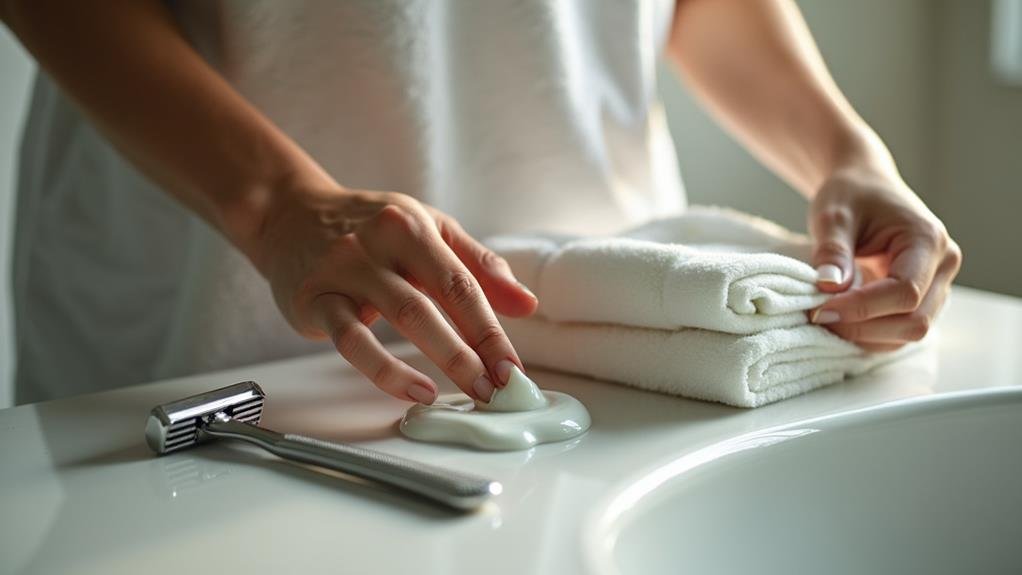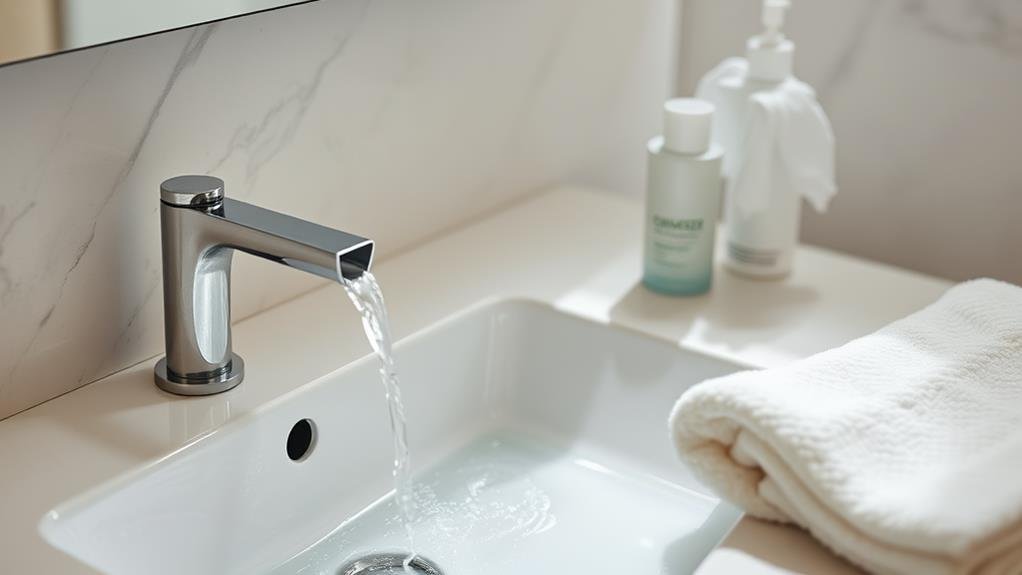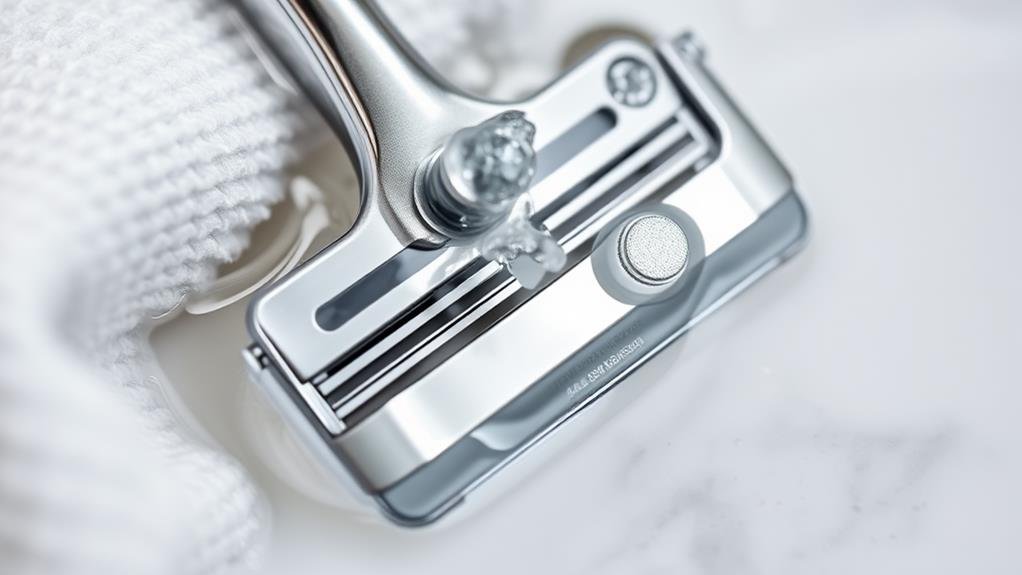
To avoid razor burn while shaving, start by choosing the right razor, such as a safety or cartridge razor. Prepare your skin by exfoliating and using warm water to hydrate. Select a quality shaving cream with soothing ingredients to reduce irritation. Always shave with the grain of your hair to minimize discomfort, and rinse your skin with cool water afterward. Remember to moisturize your skin post-shave to restore its barrier and avoid shaving over any existing irritation. Finally, maintain your razor blade by cleaning and replacing it regularly. You'll find additional insights by exploring more strategies.
Key Takeaways
- Choose the right razor type and blade material to suit your shaving needs and skin sensitivity.
- Prepare your skin by hydrating and exfoliating to reduce friction and prevent irritation.
- Use quality shaving cream with soothing ingredients to enhance comfort during shaving.
- Always shave with the grain and use gentle strokes to minimize irritation and discomfort.
- Follow up with a cool rinse and apply a suitable moisturizer to restore skin moisture and barrier.
Choose the Right Razor

Choosing the right razor is essential for minimizing the risk of razor burn. When selecting a razor, consider the various razor types available, including straight razors, safety razors, and cartridge razors. Each type offers distinct advantages and disadvantages.
Straight razors, for instance, provide a close shave but require skill and practice. Safety razors, on the other hand, offer a balance of safety and efficiency, making them a popular choice among those seeking precision with less risk. Cartridge razors are convenient and easy to use, but they may not deliver the same level of closeness.
Equally important is the choice of blade materials. Stainless steel blades are known for their sharpness and durability, while carbon steel blades can offer an exceptionally smooth shave but may require more maintenance.
When you select a razor and blade, consider your skin type and hair texture. Softer blades are often better for sensitive skin, while stiffer blades can handle coarser hair more effectively.
Prepare Your Skin Properly
To achieve a smooth shave and minimize razor burn, you must prepare your skin properly.
Hydrating your skin before shaving softens the hair and reduces friction, while regular exfoliation removes dead skin cells, preventing clogged pores.
Implementing these practices creates an optimal environment for shaving, enhancing comfort and effectiveness.
Hydrate Before Shaving
Hydration plays a crucial role in preparing your skin for shaving, as it helps to soften hair and reduce irritation. Before you shave, it's essential to ensure your skin is adequately hydrated. This is particularly important if you shave frequently; the more often you shave, the greater the need for hydration to protect your skin from damage.
Your skin type also influences how well hydration works. If you have dry or sensitive skin, you may need to apply a moisturizing product or use warm water to hydrate your skin effectively. For oily skin types, lighter hydrating gels or creams can be beneficial.
To maximize hydration, consider showering or soaking your face with warm water for a few minutes before shaving. This process opens up the pores and allows for better hair softening.
Additionally, using a pre-shave oil can create a protective barrier, further reducing friction during shaving.
Exfoliate Skin Regularly
Exfoliating your skin regularly is essential for preparing it properly before shaving. This process removes dead skin cells, which can trap hair and lead to razor burn. By incorporating exfoliation into your routine, you'll experience numerous exfoliation benefits, including smoother skin and a closer shave.
To effectively exfoliate, consider using various exfoliating tools such as scrubs, brushes, or chemical exfoliants. Each tool has its own advantages; for example, scrubs can provide immediate results, while chemical exfoliants can offer deeper penetration and longer-lasting effects.
Aim to exfoliate at least two to three times a week, adjusting based on your skin type. If you have sensitive skin, choose gentler products to avoid irritation.
The goal is to prepare your skin without causing damage, allowing for a more comfortable shave.
Use Quality Shaving Cream

When you prepare to shave, using quality shaving cream can significantly reduce the risk of razor burn. Quality shaving creams contain quality ingredients that enhance your shaving experience. They create a protective barrier, allowing the razor to glide smoothly over your skin, minimizing irritation.
Here's a comparison of common shaving cream benefits:
| Shaving Cream Type | Benefits |
|---|---|
| Gel | Provides a cooling effect, hydrates skin |
| Cream | Thick consistency for optimal moisture |
| Foam | Light and airy, easy to spread |
| Organic | Natural ingredients, less irritation |
| Sensitive Skin Formula | Specifically designed for delicate skin |
Choosing a shaving cream that suits your skin type is essential. Not all creams are created equal; some may contain harsh chemicals that aggravate your skin. Look for products with soothing ingredients like aloe vera or chamomile. These can help calm your skin and enhance the shaving cream benefits. By selecting the right shaving cream, you empower yourself to enjoy a smoother, irritation-free shave, giving you the freedom to express yourself confidently.
Shave With the Grain
Shaving with the grain is a crucial technique for minimizing razor burn and achieving a smooth shave. When you shave in the direction of hair growth, you reduce the risk of irritation and discomfort. This method aligns with effective shaving techniques, allowing the razor to glide over your skin more effortlessly, which can significantly decrease the chances of nicks and cuts.
To determine the direction of hair growth, run your fingers across the area you're shaving. You'll notice that hair typically grows in a specific pattern. By shaving with the grain, you're allowing the razor to cut the hair at its base, which helps prevent the hair from becoming trapped beneath the skin's surface—a common cause of razor bumps.
It's important to remember that everyone's hair growth patterns differ, so take the time to identify yours. While it might be tempting to shave against the grain for a closer shave, doing so can lead to increased irritation and razor burn.
Prioritizing comfort and skin health is essential. Embrace the freedom that comes with mastering this fundamental technique, and enjoy a smoother, more comfortable shaving experience.
Rinse and Moisturize

Rinsing your skin and applying moisturizer after shaving are essential steps to prevent razor burn and soothe irritation. This post shave care routine not only helps calm your skin but also facilitates recovery, minimizing the risk of irritation.
Begin by rinsing your face with cool water to remove any remaining shaving cream and hair. This action closes your pores, reducing the likelihood of bacteria entering and causing inflammation.
Next, choose a suitable moisturizer tailored to your specific skin type. If you have oily skin, opt for a lightweight, non-comedogenic formula that helps maintain moisture without clogging pores. For dry or sensitive skin types, look for richer creams containing soothing ingredients like aloe vera or chamomile. These components provide hydration and reduce redness.
Don't forget to apply your moisturizer gently, allowing it to absorb fully. This step is crucial for restoring your skin's natural barrier, which can be compromised during shaving.
Avoid Shaving Over Irritation
When you notice irritation on your skin, it's crucial to identify those problem areas before you continue shaving.
Adjusting your shaving technique can help prevent further aggravation and minimize discomfort.
Identify Problem Areas
Many people experience irritation in specific areas of their skin, making it crucial to identify these problem spots before you start shaving. Sensitive skin often reacts adversely to shaving, leading to discomfort and razor burn.
Pay close attention to areas where irritation commonly occurs, such as the neck, underarms, and bikini line. These regions may require extra care due to their sensitivity.
Observe the hair direction in these spots. Hair typically grows in different directions, which can complicate your shaving process. If you shave against the grain in sensitive areas, you increase the risk of irritation.
By recognizing where your skin is particularly reactive and understanding the hair direction, you can avoid unnecessary trauma to your skin.
Before you shave, take a moment to assess your skin carefully. Look for any redness, bumps, or existing irritation. Steering clear of these areas or adjusting your approach can significantly minimize the risk of razor burn.
Identifying your problem areas not only enhances your shaving experience but also empowers you to maintain healthy, irritation-free skin. Prioritize awareness and adapt your routine accordingly to enjoy a smoother, more liberating shave.
Adjust Shaving Technique
Recognizing your problem areas lays the groundwork for refining your shaving technique. Once you've identified these areas, focus on adjusting your shaving angles and pressure control to avoid further irritation. Avoiding direct contact with these sensitive spots is crucial.
Here's a quick reference table to help you adjust your technique:
| Technique | Recommended Action | Notes |
|---|---|---|
| Shaving Angles | Use a shallow angle | Reduces blade friction on skin |
| Pressure Control | Apply minimal pressure | Light strokes minimize irritation |
| Avoiding Irritated Areas | Shave around sensitive spots | Prevents exacerbating existing irritation |
When approaching these adjustments, remember that less is often more. A gentle, deliberate approach can yield a smoother shave while protecting vulnerable skin. Don't rush; take your time to find the optimal angles and pressure that work for you. Experiment with different techniques until you establish a routine that keeps razor burn at bay. By being mindful of your shaving technique, you empower yourself to achieve a comfortable, irritation-free experience.
Maintain Your Razor Blade

Maintaining your razor blade is crucial for achieving a smooth shave without the irritation of razor burn. Proper blade storage and timely blade replacement are essential practices that significantly impact your shaving experience.
After each use, rinse your blade thoroughly to remove hair, soap, and skin cells. This prevents buildup that can dull the blade and increase the risk of irritation.
Dry the blade completely to avoid rusting, which can compromise its sharpness. Consider storing your razor in a dry area, away from humidity, to prolong its lifespan.
It's vital to replace your blade regularly. A dull blade tugs at the hair rather than cutting it cleanly, leading to discomfort and razor burn.
Depending on your shaving frequency and hair type, you should replace your blade every 5 to 10 shaves. Pay attention to signs of dullness, such as tugging or discomfort during shaving.
Conclusion
By following these seven strategies, you can significantly reduce the risk of razor burn and ensure a smoother shaving experience. Some might argue that these steps are time-consuming, but taking a few extra minutes to prepare your skin and maintain your razor can save you from discomfort and irritation later. Prioritizing proper technique and quality products not only enhances your shave but also promotes overall skin health. Invest in your routine for lasting results and comfort.
